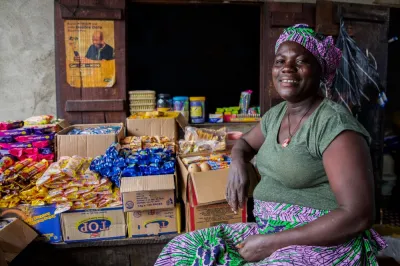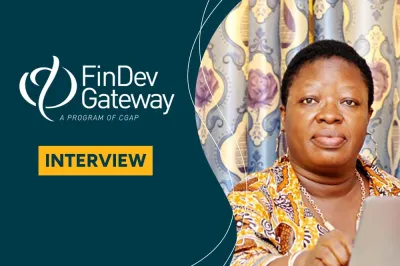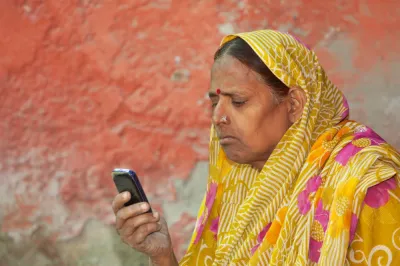How Do We Reach 80 Million Women and Increase Their Incomes by 30%?

Greta Bull is the Director of Women’s Economic Empowerment at the Gates Foundation, where she oversees a portfolio of investments covering gender data and evidence, women’s economic collectives (WECs) and livelihoods development for poor women. Prior to joining the foundation, Greta worked for 15 years at the World Bank Group, where she served for six years as the CEO of CGAP.
The Gates Foundation recently published the white paper, Women and Equitable Growth in a Resource-Constrained World, as part of its work on Women’s Economic Empowerment and Inclusive Financial Systems. This publication, which argues that we need to focus on building inclusive credit markets, especially in Africa, represents a significant shift from recent thinking in the sector. FinDev Gateway sat down with Greta Bull, the lead author of this paper, to discuss what it means for the financial inclusion sector as a whole.
FinDev Gateway: Why did Gates Foundation do this work that led to the white paper, “Women and Equitable Growth in a Resource-Constrained World”?
Greta Bull: Our strategy, our North Star, is focused on increasing women’s income. So how do we do this? How do we reach 80 million women and increase their incomes by 30%? As we looked into this question, we realized that we need to start where women are. And a lot of women are in the informal economy, running nano, micro and small enterprises. And one of the things those enterprises most need is access to affordable sources of capital.
We use the word capital very intentionally here because it doesn’t have to be a loan; it could be a cash transfer or a capitalization grant to a VSLA. But it could also be credit, provided through a group or an MFI or a fintech. What’s important is that we need to get capital out to women in ways they can use to productively increase their incomes. And we need to do so at a price point that is affordable and represents the demonstrable risk of that woman defaulting on the loan.
So, where do women get the capital they need? We have the informal credit ecosystem –self-help groups, VSLAs, chamas. There are cash transfers and ultra-poor graduation programs. And then we have microfinance and then there’s fintech. We used to think of all these types of finance in silos, as very different from each other.
But in the end, it's all money – it either goes out in one direction (such as cash transfers) or it goes out and comes back at different price points (credit). The impact evidence for cash transfers is quite clear. With credit it is more mixed, and that is generally because the credit most poor women have access to is not suited for the needs of people who are trying to run businesses to earn income. And in Africa, the price point on that credit is VERY expensive.
We looked around and realized that other places have figured this out. Parts of Latin America back in the 90s figured out how to do microfinance pretty well. It's a really well-structured, well-run industry in countries like Peru, Colombia and Bolivia. Bangladesh figured this out. India's figuring this out. But in Africa, we have not yet gotten to a place where we have well-diversified financial sectors that can serve the large percentage of people who are not part of the system in a meaningful way and at a price point that's affordable. For example, the going rates for microloans in Kenya are in excess of 70% APR. When people in India complain about 25 to 30% interest rates, we think: we dream of those interest rates in Africa!
We came to the conclusion that this is an ecosystem problem. We're trying to figure out how we can work together across this ecosystem more effectively to start bringing that price point down for credit, just as they did in Latin America back in the day, just as they're doing in India now. And what are the mechanisms that will make that happen in a way that builds markets rather than distorts markets or leaves us at the mercy of the private sector (which is partly why it costs so much now)?
As donors, we have to be smarter about how we're buying that impact. We’re spending $10 billion a year on financial inclusion in Africa, and what's it buying us? We need to start getting more for our money in these markets.
The role of credit for women's microenterprises
FinDev: Microcredit received a lot of criticism in the past decade, stemming from negative press and randomized control trial (RCT) studies showing mixed results on impact. Why are we coming back to focus on credit now?
Greta: As I mentioned, women need capital. Credit is one solution. Cash transfers are another. But there isn’t a lot of money to go around now as ODA (official development assistance) is very constrained. So, credit has the advantage that it can be leveraged and used in a way that it comes back and can be used again. We're trying to reset the conversation on how we think about credit as a resource - and it's microcredit because most women’s businesses are small and informal.
Credit can play three distinct roles: 1) Resilience: you have a problem and need to pay for something pronto; 2) Working capital, to smooth out irregular cash flows; and 3) Investing in growth. The industry has traditionally focused on growth and not enough on the resilience and stability use cases. What financial diaries tell us is that most microenterprises don’t want to grow. They want a reliable and steady income. How do you get enough of these low-income women on to a footing where they can run stable microenterprises that can reliably employ people, so we can start generating employment and income for women? Once you have that kind of stability, you can start thinking about growth. And, by the way, stability means you can continue to employ people rather than having to lay people off when cash flows are tight.
We tried to dispel this notion that the RCTs all said that microcredit is bad and we shouldn't be doing it. That's not what they said. What they said is, microcredit matters, but it's being commercialized, and donors need to think carefully about where they put their money, investing it in ways we know have greater impact. Because impact only happens under certain circumstances.
As donors, we have to be smarter about how we're buying that impact. We’re spending $10 billion a year on financial inclusion in Africa, and what's it buying us? We need to start getting more for our money in these markets.
FinDev: What do you mean about getting more for our money?
Greta: For example, if we're offering first loss guarantees on lending portfolios, what are we getting in exchange for the fact that the risk to that lender is reduced, sometimes significantly? If the policy environment is right, and Kenya is exploring policy action on this, then lenders should be able to reduce their prices because their cost of risk is lower. We need to find ways for our funding to be catalytic, so we're not just helping some big commercial bank’s CEO to avoid a loss, but we're actually getting some real impact in exchange.
Even in a well-advanced market like the U.S., building out inclusive finance doesn't always work on a purely commercial basis - this comes out beautifully in Tim Ogden’s and Joyce Klein’s recent working paper. If we are really looking to develop inclusive finance that helps to build economies, we need to start thinking about this differently. We need to think about how subsidy can help providers reach lower income and often invisible parts of the market in ways that don’t place an undue risk burden on the lender while keeping costs affordable.
Considering subsidy for serving low-income and excluded clients
FinDev: Subsidy has often been considered a bad word in microfinance, but that seems to be shifting now, with your work at the Bill & Melinda Gates Foundation as well as other recent research, such as Tim Ogden and Jonathan Morduch’s paper, What Win-Win Lost: Rethinking Microfinance Subsidy in the Past and Designing for the Future. They argue that the “win-win” model of microfinance, in which both FSPs and low-income clients gain from this commercial, profit-oriented model, has been a false narrative - that we need to rethink the role of subsidies for this sector and accept the reality of its necessity for serving poor and excluded clients. Would you agree?
Greta: Yes, absolutely. We have to be smarter and yes, we need to think about subsidy. We subsidize this industry in the United States. We have 30-year fixed rate mortgages because the government implicitly subsidizes that rate stability. We have CDFIs (community development financial institutions) that are able to fund themselves at the cost of US treasuries. We have specialized loan funds that incentivize things like investment in clean energy. We've been using subsidies in the United States for many years.
So why do we think that in Africa we should be lending to very low-income people on purely commercial terms? What we end up with is digital consumer credit, because that's what you can actually earn a profit doing on a fully commercial basis. The question I would ask in this instance would be: is digital consumer credit an appropriate way to use government subsidy? We argue that it would be better used to build sustainable and inclusive credit markets so that women can run stable businesses and invest in growth. We need to think about credit as a tool that's part of a much bigger toolbox for poverty alleviation and growth, which is what most African countries’ governments are focused on now.
You know, the South Asians and the Latin Americans were lucky because they got to this space early while donors were still willing to do all the things needed to make this work. But the problem is we didn't do all the market building stuff that needed to happen first to make that work. You can't find a magic silver bullet institution that is going to solve all this stuff for you. You have to tackle this across an ecosystem.
The issue we see with many funders in this space is that there is a tendency to equate impact with the number of loans made. But that's not impact. That's counting loans.
FinDev: Who do you think will be the hardest to convince in terms of transforming these ecosystems and resetting how we think about this whole spectrum of financing that people require, from concessional all the way to commercial?
Greta: I think everybody's going to be hard to convince. But to be honest, I think it'll be the hardest with the banks and the DFIs (development finance institutions) because the system as it is currently structured works very well for them. For example, in Africa, we have some of the most profitable and at the same time the least efficient banks in the world.
The issue we see with many funders in this space is that there is a tendency to equate impact with the number of loans made. But that's not impact. That's counting loans. What we are not doing is drilling down and seeing what those loans did for people’s businesses and their incomes.
And so I'd like to challenge the DFIs and the funders to really trace through and demonstrate that they are reaching, say, the woman who's selling tomatoes in the market or the person who's running a machine shop in Kenya or any small business.
Something has to change and it's going to require doing things differently. It's going to take transformation of the financial sector to make this work and a recognition that it can't all be done commercially. We are going to need regulatory and policy change. We will need much greater sharing of data. We will need better institutions, who are able to design and deliver products that offer their customers meaningful services. And it will take funders who are willing to push their partners towards greater impact in their financial services work.
FinDev: Do you think part of the reason it could be hard to convince DFIs and everybody else is because we are still figuring out impact? CGAP, for example, has launched its initiative to generate more evidence around the impact of microfinance.
Greta: Look, define impact for me. Is it that you made a loan to a woman? That's not impact. That's actually an output in my book. So what was the outcome of that loan and what was the impact?
We have RCTs that say that loans do have impact under certain conditions, and that donors need to focus their efforts on supporting impact-driven lending. So, who is impact-driven? I think MFIs are genuinely impact first, but they've been left to fend for themselves in a commercial world, and to be honest, many of them have struggled in the age of digitization. On the other hand, banks are mainly balance sheet optimizers and fintechs are incentivized to grow, and that’s what we should expect from them.
If we can crack the nut for women, then I think we can crack the nut for the whole ecosystem. But you have to start with women because it's harder. They're getting credit on worse terms. They're mostly inhabiting this informal ecosystem.
Opening up a pathway for women in the credit ecosystem
FinDev: To make capital available to women, you say that we need to focus on the entire ecosystem. Why?
Greta: This is a really important point. Women are overrepresented in informal lending and borrowing structures, and they need a pathway to grow and move into other productive opportunities. So how do you connect these different ecosystems? If you look at the paper, we have this step ladder in it: Women on the left, money on the right. How do you move women up and money down? That's really what we're trying to make happen.
We have to recognize that women are in the lower ends of these segments. Women are in the rural economy. Everybody says there are too many microenterprises in Africa. I say there aren't enough microenterprises in Africa. What we have is too many people, especially women, eking out a living on very small farm plots. We actually need more microenterprises. We have to start with where women are, and we have to give them pathways to become more productive.
Part of that will be access to markets – which is another part of our overall livelihoods strategy. But it’s also about access to capital, which is our focus in this white paper. We need to have capital availability all the way from the smallest nano enterprise through to medium-sized and large enterprises, if they're run by women. But women tend to be very disadvantaged in all of these ecosystems, so they cluster at the bottom because they can't get a toehold.
If we can crack the nut for women, then I think we can crack the nut for the whole ecosystem. But you have to start with women because it's harder. They're getting credit on worse terms. They're mostly inhabiting this informal ecosystem. Many of them may be happy to be there, but some proportion of them would benefit from breaking out of that ecosystem and being able to get individual loans.
Right now, there's no pathway for them to get there.
FinDev: Where do you take this work from here? What's next?
Greta: We are building out proof points to show that there are ways we can move this ecosystem. And we're building partnerships that try to get at these issues. But let's be honest, this took 20 to 30 years for places like Peru and India to build out. This is not going to happen overnight. This is a long-term journey, so we're really looking for fellow travelers to come with us on this journey. And we're going to need the people who have the money to come along. We're going to need the people who manage the regulatory and policy environment. We're going to need the impact-first providers in this mix. And we're going to need the donors to come to the table. And so we’re trying to find those partnerships with fellow travelers that can help shift things.
Especially for women, because it's hardest for women.


